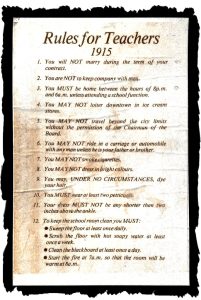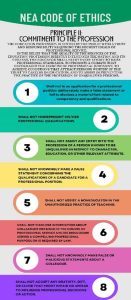 Preparing to Learn
Preparing to Learn
Rules for Teachers, 1915
Thankfully, rules for teachers have changed since 1915, and there continue to be rules for teachers that are important to the profession. The first topic we will address in this course is teachers’ many responsibilities in addition to teaching in a classroom. The teaching profession is guided by strict codes of professional ethics and a standard of professionalism not always expected in other professions.
Teachers’ Rights and Responsibilities
The National Education Association’s Code of Ethics for Teaching includes two principles. The first is the commitment to the student, and the second is the commitment to the profession. The images below encapsulate the code.
 Deeper Dive
Deeper Dive
First Amendment Explained
Congress shall make no law respecting an establishment of religion, or prohibiting the free exercise thereof; or abridging the freedom of speech, or of the press; or the right of the people peaceably to assemble, and to petition the Government for a redress of grievances. —First Amendment, Constitution of the United States
While the first amendment concerns free speech, teachers must remain neutral so all students and families can feel safe in the classroom. Teachers TEACH all sides of an issue so that students learn to analyze critically and be open to others’ ideas. Teachers do not PREACH or share their personal opinions, including by posting political affiliations in our classroom or commenting on religious or political views or opinions.
- Politics In The Classroom: How Much Is Too Much? (Steve Drummond, NPR)
- Social Networking Nightmares: Cyberspeak No Evil (Mike Simpson, National Education Association)
- Engaging in Appropriate Conversations (Teal Ruland, National Education Association)
Netiquette= Professional Communications on the Internet
Several rules of etiquette are essential to know and use when communicating electronically, and these guidelines can be referred to as “Netiquette.” As professionals-in-training, follow these Netiquette rules in all course communications.
- When writing an email, Identify yourself:
- Begin messages with a salutation (e.g., “Dear Dr. Beach) and end them with your name (“Warm Regards, Hannah.”)
- Use a signature (a footer with your identifying information) at the end of a message.
- Include an informative subject line.
- Include a descriptive phrase in the message header’s subject line that tells the message’s topic. Referencing the course number is helpful.
- Avoid sarcasm.
- Sarcasm without body language and tone of voice cues can be difficult to interpret.
- Avoid miscommunication by also avoiding sarcasm.
- Respect others’ privacy.
- NEVER quote or forward an email from someone else without the person’s express permission.
- Acknowledge and return messages promptly.
- If you cannot take care of the request right away, let the sender know it was received (e.g., “received—this will take me time to check.”)
- If no request is included in the email, courtesy requires acknowledgment of receipt (e.g., “received, thank you!”)
- Copy with caution.
- Do not copy everyone you know on each message.
- Do not use BCC (Blind Carbon Copy) as a method to go behind someone’s back. The purpose of BCC is to send to many people while keeping recipients’ email addresses private.
- Do not open or forward spam (a.k.a. junk mail).
- Do not contribute to worthless information online by sending or responding to mass postings of chain letters, rumors, etc.
- Be concise.
- Keep messages concise—a maximum of one screen, as a rule of thumb. If the communication is a page or more, a phone or f2f conversation may be a more appropriate communication venue.
- Use appropriate language.
- Avoid coarse, rough, or rude language or slang.
- Observe proper grammar, punctuation, and spelling
2015 Michelle Beach. All Rights Reserved.
Face-to-face communication includes both verbal and nonverbal communication. Face-to-face communication with the administration, other teachers, and staff should remain professional. The teachers’ lounge has a reputation for being a place where teachers speak about their students and other topics that could be considered a breach of FERPA (the Family Educational Rights to Privacy Act).
 When discussing a student with caregivers, use the sandwich method. Begin with a positive statement, share any concerns, and end with a positive statement. Remember that a caregiver is the expert on the student and takes their input as a team member who wants the best for the student. Clarify that all have a mutual goal: success for the student. Stay positive but be honest with concerns about student needs. Share successes the student has had, be it art, math, social skills, or being a classroom helper.
When discussing a student with caregivers, use the sandwich method. Begin with a positive statement, share any concerns, and end with a positive statement. Remember that a caregiver is the expert on the student and takes their input as a team member who wants the best for the student. Clarify that all have a mutual goal: success for the student. Stay positive but be honest with concerns about student needs. Share successes the student has had, be it art, math, social skills, or being a classroom helper.
Professional dress codes are a critical component of work ethics. Look around: What types of clothing is ethical to wear for the teaching profession? While the dress code varies by school and location, it involves business casual. Clothing should be clean and well maintained, with no obvious stains, wear and tear, or destruction. It is against many school policies for teachers to wear anything that is sheer or see-through, ill-fitting, or items displaying any text or graphic viewed as inappropriate. Most schools do not allow shorts and most prohibit leggings. Schools may have Friday “Jeans Day” but discourage jeans on other days. Check with your individual school for their dress codes.
Ethical dressing includes refraining from wearing clothes with tears, rips, and wrinkles. Following fashion trends that include rips or tears can be worn after hours but is not appropriate in the school environment. Wearing baggy sweats and t-shirts communicate to others that this is not an important job.
Teacher attire does not have to be complicated. Wearing clean, ironed clothing such as pants and shirts or dresses that fit the body properly without showing too much skin is standard. Male teachers can wear ties, dress shirts, or even a collared shirt and nice pants. Clothes should be clean and pressed. Hair should be washed and styled. Apply understated makeup and remove piercings. Cover tattoos with clothing or makeup or band aids. Makeup should be understated.
How a person dresses elevates them to the respect they want to receive. Kashem (2019) studied the effects of teachers’ attire on students’ attitudes and learning. Kashem found that students perceived a well-dressed teacher as more organized and prepared. The researcher also noted the reinforcement of the teacher’s hierarchy by what they chose to wear. Wear comfortable clothing and shoes that will hold up to standing and moving throughout the day.
Keep a mirror by the door. Before leaving for school, do the bend-over test. Bending forward, does the shirt or top stay closed? Is there any cleavage? Are there any gaps between your shirt and pants at the midline? Turn around and check, is your backside covered between the pants and shirt? Finally, while you are turned around, ensure that no skin shows below the neck except for hands.
 Reflect
Reflect
Ethical Considerations for Teachers
- Identify four tips from the e-mail, face-to-face, and professional dress codes above. How would you support their importance to your success as a teacher?
- What idea could you incorporate into your teaching that would demonstrate your understanding of ethics?
- When meeting with the caregiver about their child failing a course, what approach would be used to start the conversation?
Teacher Role and Responsibilities
A teacher’s role includes providing equitable and inclusive environments for all students, including students with special educational needs. Teachers are responsible for planning the curriculum and providing accommodation and modifications for students with special education needs. Effective teachers know students’ strengths and needs and take the time to plan the curriculum accordingly. Developing a solid understanding and knowledge of teaching strategies will assist in the planning and preparation.
The teacher is also responsible for knowing their students’ backgrounds, including family makeup and culture. The student’s Individual Education Plan (IEP) meeting is integral to their education. All stakeholders need to develop a relationship for the child’s success. Whether a general education or special education teacher, professionals must be responsive and respectful of the student’s family.
When a student in the classroom has a disability that is rare or not commonly understood, it is the teacher’s responsibility to research and learn more about it. Just as it is the teacher’s responsibility to know the curriculum, the teacher must also know the students. While studying to learn more about a disability or disorder, use current and vetted materials. Check with reputable sources, research through medical and educational organizations, and speak with the parents. Since teachers typically teach a student for at least one academic year, teachers want to do the best for each student.
Advocating for the student is one responsibility of the special education teacher. The teacher is responsible for knowing what the student needs and supporting them to receive it. The teacher is the all-important voice of the students and ensures the students receive FAPE in the LRE.
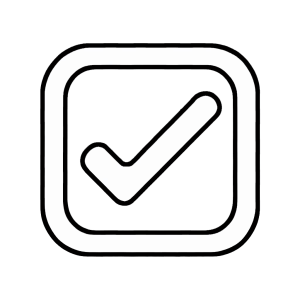 Knowledge Check
Knowledge Check
- When a classroom teacher does not have a special education degree, the teacher does not have to provide the accommodations needed for a student in the classroom with a disability.
- True/False?
- Why or why not?
- An IEP meeting must include the parents.
- True/False?
- Why or why not?
- What is the role of the classroom teacher in an IEP meeting?
- What is an IEP meeting intended to accomplish?
Procedural Safeguards
Education and related services to meet the child’s individual needs and prepare each child for post-high school education, employment, and independent living. To ensure FAPE, each child receiving special education services has an individualized education program (IEP) based on their needs. Children’s needs are based on their present level of performance and functional performance (PLAFP) and to what extent their disability affects their general education participation. It is important to note that students with disabilities receive instruction/content at their grade level, with accommodations and modifications as needed. The requirements of the IEP bind the general education teacher of a student with special education needs. The teacher is responsible for knowing the goals of the student’s IEP and being an active member of the IEP team. Consequences for not following the IEP as the general education teacher include a lawsuit.
CALL OUT BOX: Gen Ed Teacher sued for not following IEP [no link provided]
Parental Rights
Parental Rights are primary to procedural safeguards. The first right is the right of the parent/caregiver to participate in all meetings concerning their child with disabilities. A meeting can only be held with the participation of the parent/caregiver. Parents/caregivers also have the right to Prior Written Notice (PWN) when the school proposes any changes in the IEP, evaluation, or placement of the child. The PWN includes the right to examine all educational records of their child. It is also the right of the parent/caregiver to obtain an independent educational evaluation of the child if they question the outcomes or procedures of the school.
Least Restrictive Environment
The Least Restrictive Environment (LRE) is a safeguard mandated by IDEA. The Least Restrictive Environment requirement was originally part of the Education for All Handicapped Children Act (EAHCA) in 1975, which was later renamed the Individuals with Disabilities Education Act (IDEA) in 1990. LRE requires students to be educated with peers not identified as having special education needs. Removing students with special education needs from the general education classroom with their peers can only occur when the severity of their disability affects advancement in the general education classroom. A meeting of the IEP team must decide and agree on the change of placement.
 Practice
Practice
Procedural Safeguards
Procedural Safeguards, Minnesota Department of Education
- As a future teacher, use your own words to explain to a classmate what is meant by the term procedural safeguards and why it is important for you to know.
- If a student requires accommodation in your general education classroom and you do not want to spend the extra time developing accommodation, you can choose to send the student to a special education room. True or False? Why or why not?
Confidentiality/FERPA
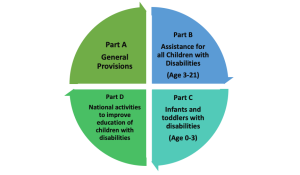
IDEA is divided into “parts”.
Part A is the general provisions and administration issues of IDEA. It includes the purpose of IDEA and definitions of terms used in IDEA. Part A: IDEA
Part B is the assistance requirements for all children with disabilities aged 3-21. Here is where you will find the formula grants to assist in providing free appropriate public education (FAPE) in the least restrictive environment (LRE) for states. Part B: IDEA
Part C are the provisions for infants and toddlers with disabilities. This portion of IDEA is for infants and toddlers, birth to age 35 months (about 3 years) and their families. It outlines early intervention services and formula grants to assist states in providing the interventions. Part C: IDEA
Part D are the national activities to improve education of children with disabilities, particularly through discretionary grants to support personnel development, technical assistance and dissemination, technology, and parent-training and information centers. Part D: IDEA
The above information, along with additional information can be found at U.S. Department of Education: IDEA; Individuals with Disabilities Education Act to find information to a particular topic in IDEA, go to IDEA: Topic Areas.
Mandated Reporting
As an educator, daycare provider, or anyone who works with minors, it is your duty and responsibility to report any suspicion of child maltreatment. Maltreatment includes harm caused to a child from neglect, physical or sexual abuse, child endangerment, mental injury or threats of injury. You are legally required (mandated) to report any suspicions or witnessing maltreatment within the last three years of knowledge. If a child tells you that they were abused within the last three years, it is just as important to report it as if you learned or witnessed maltreatment the same day.
As a mandated reporter, YOU are required to report any maltreatment. You cannot transfer the responsibility to your supervisor or administrator. The report must come from ‘first person,’ meaning YOU. Your supervisor or administrator cannot discourage or prevent you from reporting or state that in their school. You are protected by law when making a report in good faith. Good faith refers to your knowledge or observation of any signs of maltreatment.
If you suspect that a child is in immediate or imminent danger, you may call 9-1-1. You must file a report within the first 24 hours of gaining knowledge of any maltreatment. The family will not be informed who made the report.
Yes, there are consequences for failing to report a case of maltreatment. If you fail to report, you are guilty of a misdemeanor. Also, you may lose your teaching license, daycare accreditation, or any other position where you have been required to complete a background check.
The following provides additional information about when and how to report alleged maltreatment, and who is required by law to report concerns of maltreatment. Mandated Reporter Training is a self-paced learning module designed for professionals identified by law who must report if they believe a child has been maltreated. This web-based training features videos and short quizzes that can be completed through self-study. The training was updated in 2022 and is now available through the Minnesota Child Welfare Training Academy (MNCWTA).
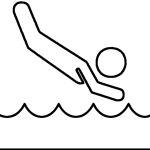 Deeper Dive
Deeper Dive
Mandated Reporting Resources and training
- Maltreatment of Minors Mandated Reporting Policy for DHS Licensed Programs DHS-7634A (PDF)
- Resource Guide for Mandated Reporters of Child Maltreatment Concerns DHS-2917 (PDF)
- Maltreatment of Vulnerable of Vulnerable Adults Reporting Policy for DHS Licensed Programs DHS-7634B (PDF)
- Vulnerable Adult Online Mandated Reporter Training
- Mandated Reporter Policy Family Child Care DHS-7742 (PDF)
- Minnesota Mandated Reporter Resources
- Maltreatment of Vulnerable adults. Complaints can be reported to the Minnesota Adult Abuse Reporting Center (MAARC) by calling (844) 880-1574 (toll free).
 Deeper Dive
Deeper Dive
Can I Be Sued?
School must pay back one year of lost learning for a child because of FAPE; Oregon judge orders Hood River County School District to pay for former student’s lost year of schooling
 Reflect
Reflect
The IDEA and Mandated Reporting
- Interpret the responsibilities of a teacher to understand IDEA and why it may or may not be important.
- Analyze why it is important for you as a mandated reporter to report a suspected case of maltreatment yourself, and not have someone else report it.
- Explain the consequences of not reporting a suspected case of maltreatment.
Examining personal bias
What is personal bias? Where does it come from? How do I know if I have it? Personal bias is not a disease that you can catch. However, it develops as you grow and mature across a lifespan. Your personal bias originates from the people and ideas that surround you. We may not always be aware of a personal bias. This section will examine personal bias as it relates to special education.
First, how do we know if we have a personal bias? An article on the American Academy of Family Physicians website shared eight tactics to identify and reduce any personal bias you may have.
These eight tactics, which spell out “IMPLICIT,” can help you mitigate implicit biases:
Introspection: Explore and identify your prejudices by taking implicit association tests or through other means of self-analysis.
Mindfulness: Since you are more likely to give in to your biases under pressure, practice ways to reduce stress and increase mindfulness, such as focused breathing.
Perspective-taking: Consider experiences from the point of view of the stereotyped person. Do this by reading or watching content that discusses similar experiences or directly interacting with people from those groups.
Learn to slow down: Before interacting with people from certain groups, pause and reflect to reduce reflexive actions. Consider positive examples of people from that stereotyped group, such as public figures or personal friends.
Individuation: Evaluate people based on their characteristics rather than those affiliated with their group. Learning to see people as individuals could include connecting over shared interests. Check your messaging: Instead of saying, “We don’t see color,” use statements that welcome and embrace multiculturalism or other differences.
Check your messaging: Embrace evidence-based statements that reduce implicit bias, such as welcoming and embracing multiculturalism.
Institutionalize fairness: Support a culture of diversity and inclusion at the organizational level. Learning to support a culture of diversity and inclusion could include using an “equity lens” tool to identify your group’s blind spots or reviewing the images in your office to see if they further or undercut stereotypes.
Take two: Resisting implicit bias is lifelong work. You must constantly restart the process and look for new ways to improve.
Adapted from Edgoose, Quiogue, & Sidhar, 2019
Types of personal bias relating to special education may include outdated terminology or the idea that students who qualify for special education are not intelligent. It is essential to check the use of antiquated and derogatory terms regarding the type of disability defining a special education student. The use of the word “retarded,” for example, was eliminated as inappropriate. In 2010, President Obama passed Rosa’s Law, which formally removed the term “mental retardation” in federal law and replaced it with “intellectual disability”
People first language is preferred when referring to people with a disability. People first language refers to using the person’s name first as a descriptor, followed by the disability or special need.” Rather than referring to Rosa as an “intellectually disabled woman,” People first language would refer to “Rosa, who has an intellectual disability.”
Some people may prefer that their disability is listed first, so it is best to check rather than assume. The identification by disability is noted particularly in the autism community. Some people prefer individuals with autism to autistic individuals. The debate comes from whether disability is considered a part of the person’s identity or whether the disability is secondary to the person considered.
Taking part in training opportunities to combat unconscious bias also helps to combat bias. Another way to combat bias is to expose yourself to your bias. If you find that you do have biases toward people with special education needs, spend more time with them. Get to know them as people.
- Volunteer with Special Olympics
- Be a classroom volunteer in a special education room
- Read books about people with special needs
- Watch videos and movies about people with special needs
The more exposure you have to people who are different from you, the more you will see bias emerge and be able to start working to eliminate it. Biases and prejudices come from not knowing. When we take the time to examine our bias and get to know people who are different from us, we see how similar we all are. Humanity is broad, diverse, and enjoyable. Suppose we were all the same. What a boring place this world would be. Learn from each other, accept differences, and respect others for who they are.
References
Kashem, M.A. (2019). The Effect of Teachers’ Dress on Students’ Attitude and Students’ Learning: Higher Education View. Education Research International, vol. 2019, Article ID 9010589, 7 pages, 2019.
Edgoose, J., Quiogue, M., & Sidhar, K. (2019, June 30). How to identify, understand, and unlearn implicit bias in patient care. Family Practice Management.
Gino, F., and Coffman, K. (2021). Unconscious bias training that works. Harvard Business Review.
Acton, C. (2022). Are you aware of your biases? Harvard Business Review.
United States Department of Justice: Community Relations Service. (n.d.). Understanding bias: A resource guide – United States Department of Justice.
